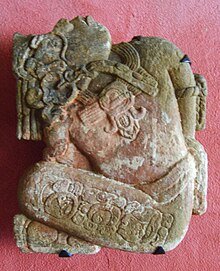
Although the Maya were once thought to have been peaceful, current theories emphasize the role of inter-polity warfare as a factor in the development and perpetuation of Maya society. The goals and motives of warfare in Maya culture are not thoroughly understood, but scholars have developed models for Maya warfare based on several lines of evidence, including fortified defenses around structure complexes, artistic and epigraphic depictions of war, and the presence of weapons such as obsidian blades and projectile points in the archaeological record. Warfare can also be identified from archaeological remains that suggest a rapid and drastic break in a fundamental pattern due to violence.
Maya polities engaged in violent warfare for political control of people and resources. Some scholars have suggested that the capture of sacrificial victims was a driving force behind warfare.[1] Among the most critical resources were water and agricultural land. Economic control of resources such as obsidian also increased competition among polities.[2] As polities became more successful, they also became more complex. This led to improved efficiency in acquiring and holding valued resources, especially through military force. Population growth increased the competition between polities, resulting in increased levels of violence.